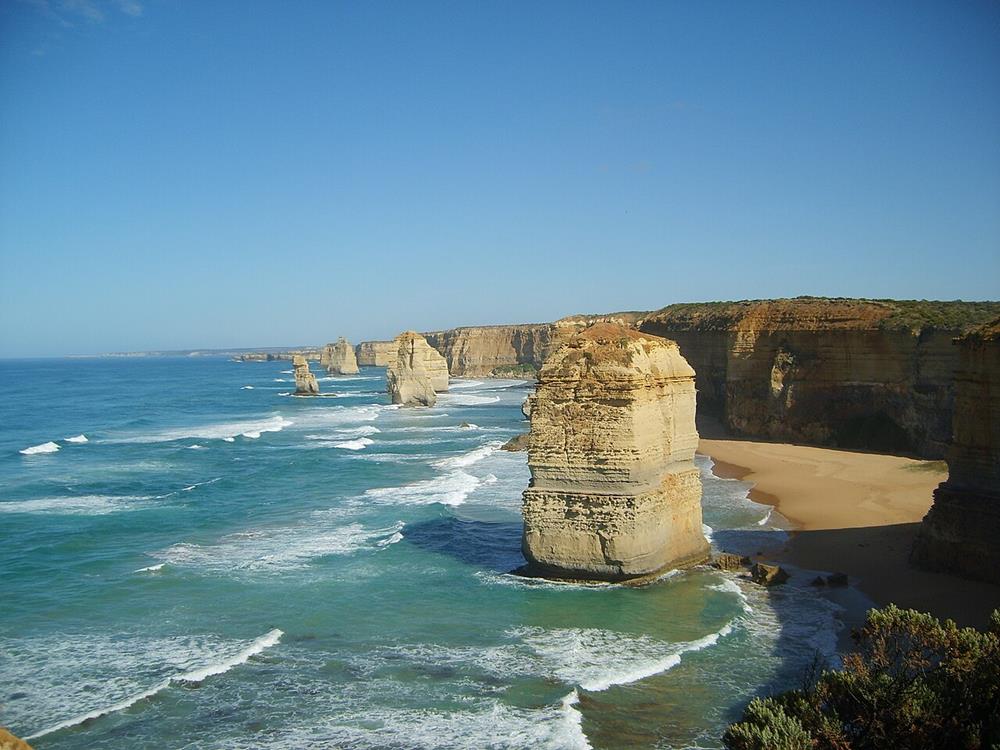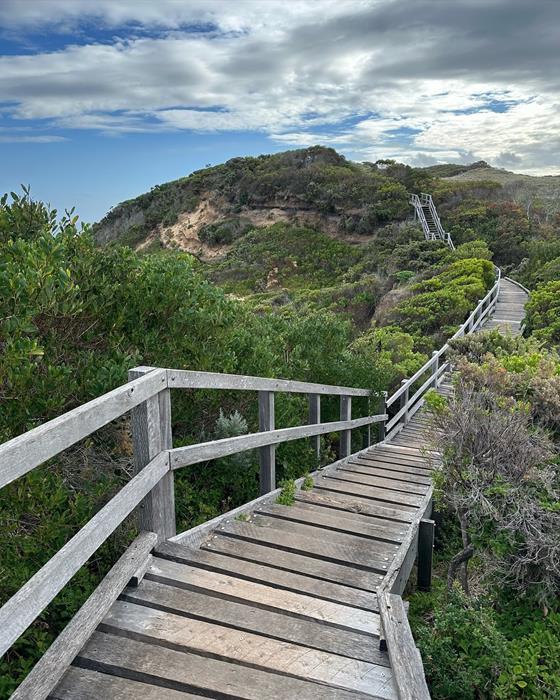Great Ocean Walk: Hiking the Dramatic Victorian Coastline Trail

The Great Ocean Walk threads along Victoria's Shipwreck Coast from Apollo Bay to the Twelve Apostles, delivering towering cliffs, quiet coves, and eucalypt forests over roughly 104–110 km (usually 5–8 days, walked east-to-west).
Expect signed tracks, beach sections, and headland lookouts that showcase the Great Otway's wild character. Parks Victoria recommends hiking east to west (with tides and surf in mind) and reminds walkers that water at hike-in camps is untreated rainwater—plan to filter or boil.
What makes this trail special is the constant shift of terrain and mood: one moment you're under manna gums with koala sightings, the next you're on wind-carved headlands watching swells roll in. The route stays close to the famous Great Ocean Road yet feels remote, with long stretches where the only sounds are surf and wind. If you want a multi-day coastal trek with real variety—but clear wayfinding—the Great Ocean Walk is a standout.
Route Overview & Classic Sections
Most thru-hikes begin at the Apollo Bay Visitor Information Centre and finish near Gibson Steps / Twelve Apostles, passing classic camps like Elliot Ridge, Blanket Bay, Cape Otway, Aire River, Johanna Beach, Ryan's Den, and Devils Kitchen. Distances between camps are designed for steady progress, but there are optional side trips—lighthouses, waterfalls, and secluded beaches—that reward extra time.
Day-walkers can sample marquee segments without committing to the full traverse. Popular choices include Blanket Bay ↔ Cape Otway for forest-to-coast transitions, Johanna Beach for big-sky surf vistas, and the Ryan's Den cliffs for dramatic granite platforms. If you're short on days, a 3–4 day "best-of" itinerary covering Cape Otway → Twelve Apostles delivers many of the trail's headline views.
When to Go
The sweet spots are autumn (Mar–May) and spring (Sep–Nov), when temperatures are moderate and winds are often friendlier—though Victoria is famous for "four seasons in one day." Pack for rapid change: a warm layer, waterproof shell, and sun protection are essential year-round. Summer brings longer daylight and warmer seas but also more visitors and stronger UV; winter rewards with moody seas, solitude, and crisp air.
Wildlife and wildflowers track the seasons too. In spring you'll see orchids and coastal heath in bloom, while autumn can bring calmer seas for safer beach traverses. Winter's heavier swells may trigger use of inland high-tide detours, so always check the marine forecast and any Parks Victoria alerts before committing to shoreline sections.
Camps, Bookings & Water
End-to-end hikers typically use the dedicated hike-in campsites (bookings and fees required), each offering tent pads, a communal shelter, and rain-tank water (treat before drinking). There's no potable water or showers at hike-in sites, and campfires are not permitted, so carry a stove and fuel. Book early for peak periods; sites are limited to keep the experience wild.
If you prefer a lighter setup, you can stage from car-accessible campgrounds or mix in local accommodation near road access points. Just remember that the spirit of the walk is self-reliance: carry enough water between sources, have a treatment method, and plan for no resupply inside the park other than what you arrange with operators.
Logistics: Shuttles, Buses & Direction
Shuttle services based along the Great Ocean Road can transfer hikers and luggage, including one-way lifts from the Twelve Apostles back to Apollo Bay after you finish. This makes linear itineraries simple and avoids backtracking to retrieve vehicles. Some operators also offer food drops, which help keep pack weights down during longer itineraries.
Public V/Line buses connect towns like Princetown / Port Campbell with Apollo Bay and inland hubs, letting you tailor start/finish points or bail out if weather turns. The route is way-marked east-to-west, and most services are designed around that direction, so plan your daily legs with bus timetables, tides, and daylight in mind.
Safety & Trail Conditions

Beach traverses are the headline thrill—and the key hazard. Many are only safe at low tide and in moderate swell; when in doubt, take the signed inland detours. Expect steep steps, exposed clifftops, and occasionally soft sand that slows pace. Carry a PLB (or satellite messenger), keep your phone charged, and store maps offline; reception is patchy in gullies and on remote headlands.
Sun, wind, and salt can be deceptively draining. Hydrate early, reapply sunscreen, and secure your hat and rain shell with the same discipline you'd use in alpine country. On hot days, start earlier and aim to finish exposed sections before mid-afternoon winds rise. On cold fronts, reduce mileage and focus on safer inland segments.
Wildlife & Leave No Trace
Koalas, kangaroos, and prolific birdlife are part of the draw, along with echidnas and, offshore, migrating whales in season. Give wildlife distance, secure food, and keep camps scrupulously clean to avoid attracting possums. Snakes are active in warmer months—wear boots, watch your step, and avoid tall grass where possible.
The coastline is fragile—stick to formed tracks, use tent pads, and pack out all rubbish. Salt-pruned heath recovers slowly from trampling, and cliff edges can undercut without warning. A small footprint preserves the wild feel that makes this route special.
Highlights You Won't Forget
Sunrise at Johanna Beach paints the dunes gold, while the sweep around Cape Otway Lightstation frames headlands that look carved by giants. The forest-to-coast transition near Aire River feels cinematic after rain, and the roller-coaster cliffs of Ryan's Den deliver constant photo stops. The finale—your first sight of the limestone stacks—lands with a jolt of awe no matter how many postcards you've seen.
Photographers should budget time for side paths to small lookouts; many of the best compositions sit slightly off the main tread. On windy days, brace elbows against a post or pack to steady long-lens shots of surf and seabirds.
Training & Preparation
Back-to-back hiking days are friendlier when legs and feet are conditioned. In the eight weeks prior, build a base with loaded day hikes (add 10–12 kg gradually), and simulate sand by walking riverside paths or parks with softer footing. If you're preparing in a city, long neighborhood walks work well—use them to dial footwear, footcare, and pacing.
Footwear should be broken-in and paired with liner socks if you're blister-prone. Pack a simple repair kit (duct tape, needle, cord), a compact first-aid kit, and a headlamp with fresh batteries. For water, combine carry capacity (2–3 L minimum) with a filter or tablets; for food, aim 3,000–4,000 kcal per day depending on load and weather.
Packing List Essentials
Keep it light but complete.
- Core kit: 60–70 L pack, 3-season tent, insulated mat, and a bag or quilt rated to the season.
- Clothing: sun hat, merino or synthetic base layers, mid-layer fleece, waterproof shell, hiking pants/shorts, and warm beanie/gloves for shoulder seasons. Add gaiters if you prefer extra protection in scrub and sand.
- Cooking: compact canister stove, 1-L pot, long-handle spoon, and windscreen. Hydration: soft flasks or bottles plus a gravity filter or chemical treatment.
- Navigation: GPX on phone and a paper map backup.
- Safety: PLB, small knife, whistle, and a few metres of cord for guy-line fixes or gear repairs.
Sample Itineraries
- Classic 6-Day: Apollo Bay → Elliot Ridge → Blanket Bay → Cape Otway → Aire River → Johanna Beach → Ryan's Den → Devils Kitchen → Twelve Apostles. This balances time on beaches and headlands with reasonable daily distances.
Fast 4-Day (West Highlights): Cape Otway → Aire River → Johanna Beach → Ryan's Den → Devils Kitchen → Twelve Apostles. Great if you've seen Apollo Bay already and want maximum cliffs-and-stacks payoff. Build in a buffer afternoon for weather or a rest stop at a scenic camp.
